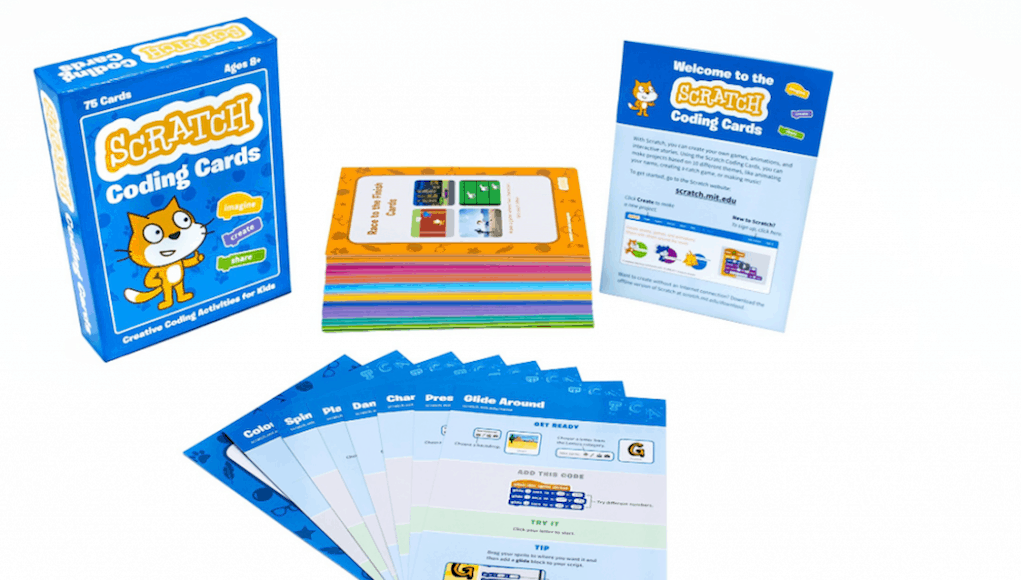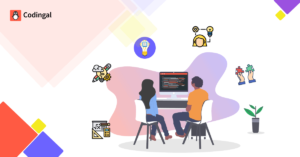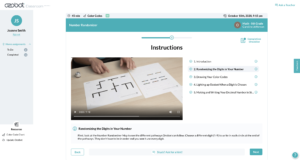Smart Review | Scratch Coding Cards

By Mary Ryerse and Luke Ryerse
What do you get when you combine a deck of cards, a laptop, clear instructions, plus room for creativity? A blended approach to coding and creating.
If you are looking for some hands-on coding activities for upper-elementary age kids, this is a great place to start. Some kids already are familiar with the Scratch website for coding—the addition of the box of The Scratch Coding Cards provides a structure that takes them beyond “click and guess” to having a set of instructions that tie the process together.
 Analogous to a set of recipe cards that can be adapted or combined, the Scratch Coding Cards were created by lead developer Natalie Rusk and her team at the MIT Media Lab, with the goal of providing an inviting entry point to Scratch. This kid-friendly approach to coding—used by millions of kids around the world—allows young people to program their own interactive stories, games and animations.
Analogous to a set of recipe cards that can be adapted or combined, the Scratch Coding Cards were created by lead developer Natalie Rusk and her team at the MIT Media Lab, with the goal of providing an inviting entry point to Scratch. This kid-friendly approach to coding—used by millions of kids around the world—allows young people to program their own interactive stories, games and animations.
The focus of this blog—co-written by our 9-year-old, Luke and myself—is on our experience testing it out.
USING THE KIT
We started by downloading the app within our Chrome browser, inserting the memory card and putting something on there. Instructions were solid enough to get it done
Luke and I selected certain cards from a colorful 75-card deck to create a variety of interactive programming projects. With the cards at our side, and a laptop in front of us, we created a simple soccer game, made a dancing version of his name, and still and have a few more projects on our list (e.g. creating a virtual pet and playing hide-and-seek).
The cards gave us step-by-step instructions to start coding. The front of the card showed us the main idea of the activity (like animating a character or object). The back gave the “how-to” of putting together code blocks to make the project come to life!
|
Front of Card:
|
Back of Card:
|
MOM’S PERSPECTIVE
What Mom liked best about this set:
- Hands-on and blended. As a mom of three boys, I know hands-on activities are important. Sometimes a screen by itself can be challenging. It was great to have step-by-step instructions at our fingertips.
- Classic color coding. The cards are clear and organized – reminds me of a combination of Lego instructions, a set of recipes, and Uno cards (a bit oversimplified, but you get the idea). The color coding and organization make the projects easy to follow.
- Independent work. Luke could do 90% of the process independently.
- Reinforcing the right things. I liked that the kind of skills we hope kids learn – thinking creatively, reasoning systematically, and working collaboratively are all reinforced and practiced.
- Dose of persistence and SEL training. The cards weren’t always easy, so Luke needed to apply his social emotional learning (SEL) skills and stay positive – and even ask for some help.
Overall, I liked the fact that I could take 10-15 minutes to help Luke get logged in and started, and then he was independent in both his motivation and his coding.
 9-YEAR OLD’S PERSPECTIVE
9-YEAR OLD’S PERSPECTIVE
I really liked having the cards. I had tried coding with Scratch before but the cards made it easier. Here’s what I liked:
Stack of cards.I liked that I could draw from the cards instead of just looking at a blank screen.
Instructions. They helped me get further by giving me more ideas of what to code.
Creativity. It made me learn different things. It helped me think of creative things I’ve never seen before or thought of before. I didn’t know I could pick my background from a picture I took myself.
Helpful tips. There were helpful tips that I didn’t have to use but I could if wanted.
Sometimes I got frustrated because I wanted to do it a way different than the instructions. But I know I also learned more because of how the cards told me the steps. I would tell my friends to use, especially some of my buddies who like to code.
For more fun activities to do with your kids, check out:
- Technology Will Save Us is Powering MakerEd in UK
- Smart Review | SAM Labs Inventor Kit
- Smart Review | Education App Gets Kids AND Parents Engaged in Learning
Stay in-the-know with all things EdTech and innovations in learning by signing up to receive the weekly Smart Update. This post includes mentions of a Getting Smart partner.








0 Comments
Leave a Comment
Your email address will not be published. All fields are required.